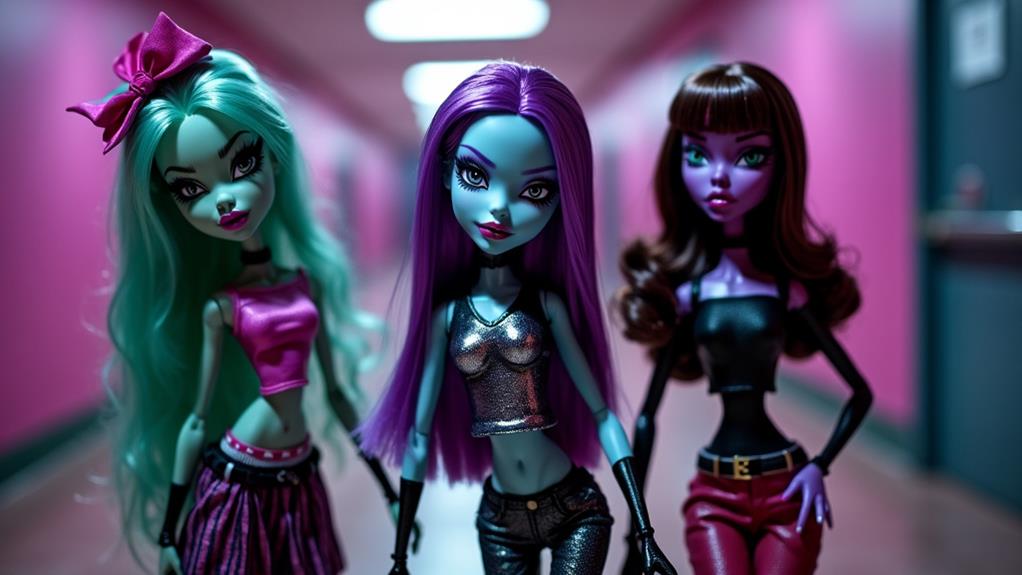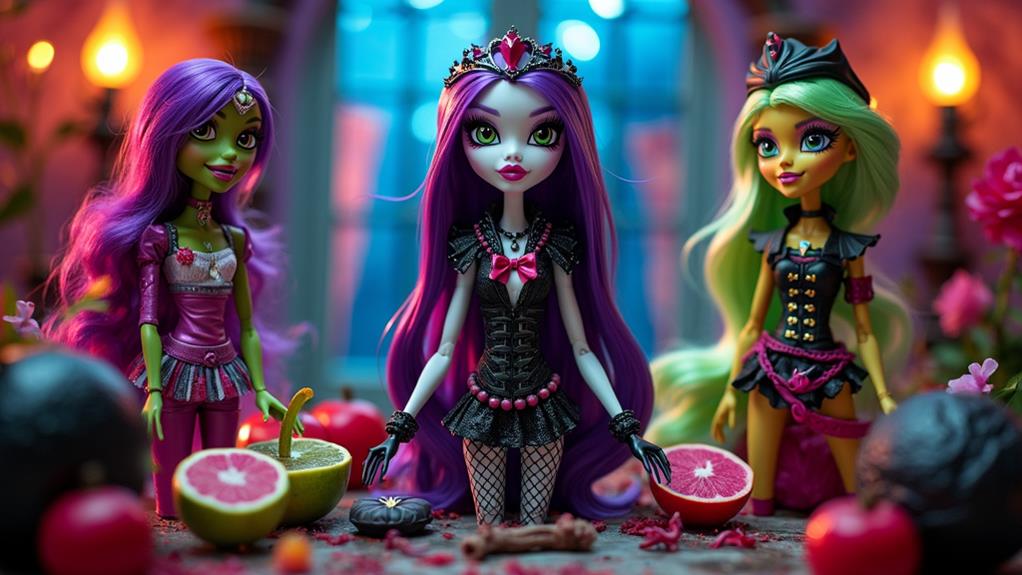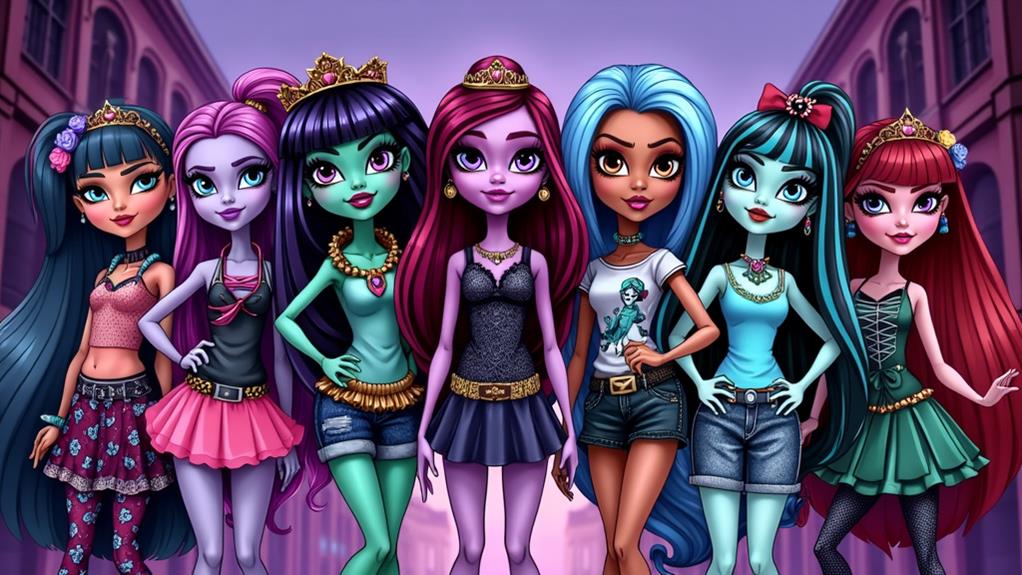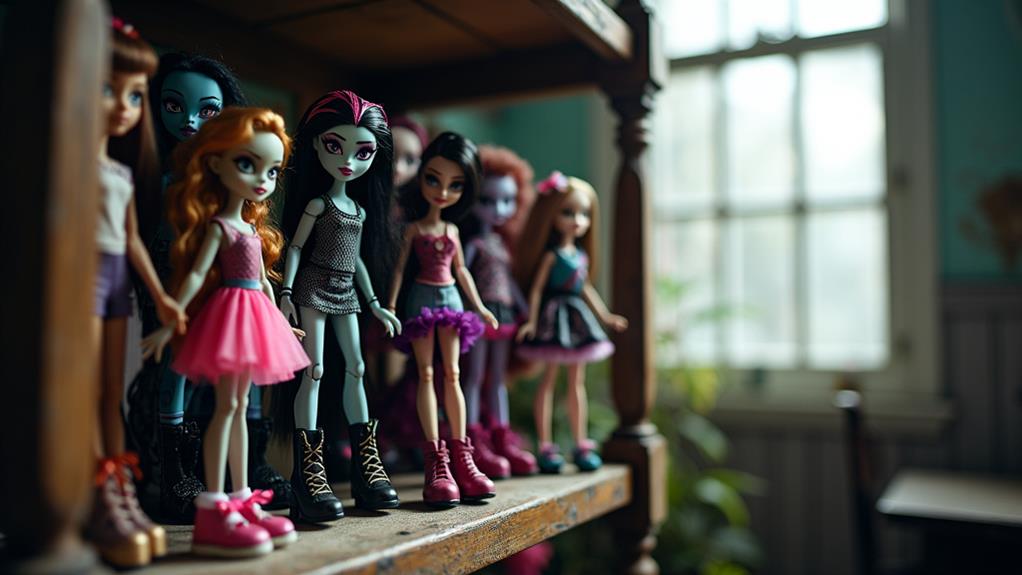When Did Monster High Lose Popularity?
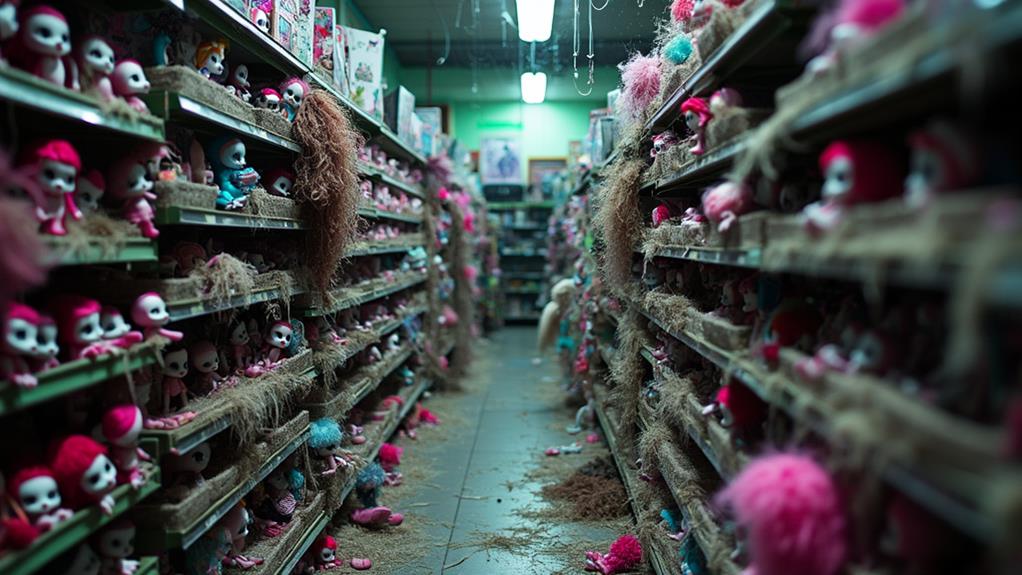
Monster High, the beloved doll line launched by Mattel in 2010, started losing popularity in the mid-2010s. Market competition and shifting trends played key roles. With rivals releasing similar products and consumer interests evolving, Monster High struggled to maintain its unique edge. Sales dropped as families favored more versatile or educational toys. Even attempts to overhaul the brand, through character redesigns and new marketing strategies, couldn't completely revive its past glory. To understand the full path and what lies ahead for Monster High, stay tuned.
The Birth of Monster High
The birth of Monster High began in 2010, when Mattel launched a unique doll line that would soon capture imaginations worldwide. You could instantly tell that these weren't your average dolls. Their character design was bold and distinctive, blending classic monster tropes with modern teenage fashion. Each doll had its own backstory, personality, and style, from Draculaura's vampiric charm to Frankie Stein's electrifying look.
You'd be amazed at how quickly Monster High made a cultural impact. The brand didn't just stop at dolls; it expanded into web series, books, and movies, all of which were enthusiastically consumed by a growing fanbase. The message was clear: it's okay to be different. This was a revitalizing change from the typical portrayal of perfection in other doll lines, making Monster High a hit among kids and parents alike.
The character design set a new standard in the toy industry, encouraging inclusivity and diversity. You'd find that these dolls celebrated quirks and individuality, promoting a message of acceptance. This cultural impact resonated deeply, helping Monster High carve out a unique niche in a saturated market.
Peak Popularity Years
During its peak popularity years, Monster High truly skyrocketed in cultural significance. You couldn't walk into a toy store without seeing the iconic characters like Draculaura, Frankie Stein, and Clawdeen Wolf. These dolls weren't just toys; they were symbols of individuality and self-expression. Monster High's cultural impact was profound, capturing the hearts of kids and even adults who appreciated its unique take on fashion, friendship, and acceptance.
The franchise didn't just stop at dolls. It expanded into animated web series, TV specials, and even movies, creating a multi-platform experience that captivated its audience. The storytelling was rich, the animation was lively, and the characters felt relatable, yet fantastical.
- Dramatic school hallways filled with ghoulish lockers and lively, monster-themed decorations
- Elaborate costumes that combined gothic elements with modern fashion trends
- Catchy, memorable theme songs and musical numbers
- A diverse cast of characters that represented different backgrounds and personalities
These elements contributed to a world where being different was celebrated. The brand's inclusive message resonated widely, setting a new standard for what a children's franchise could be. Monster High wasn't just a phase; it was a movement.
Market Competition
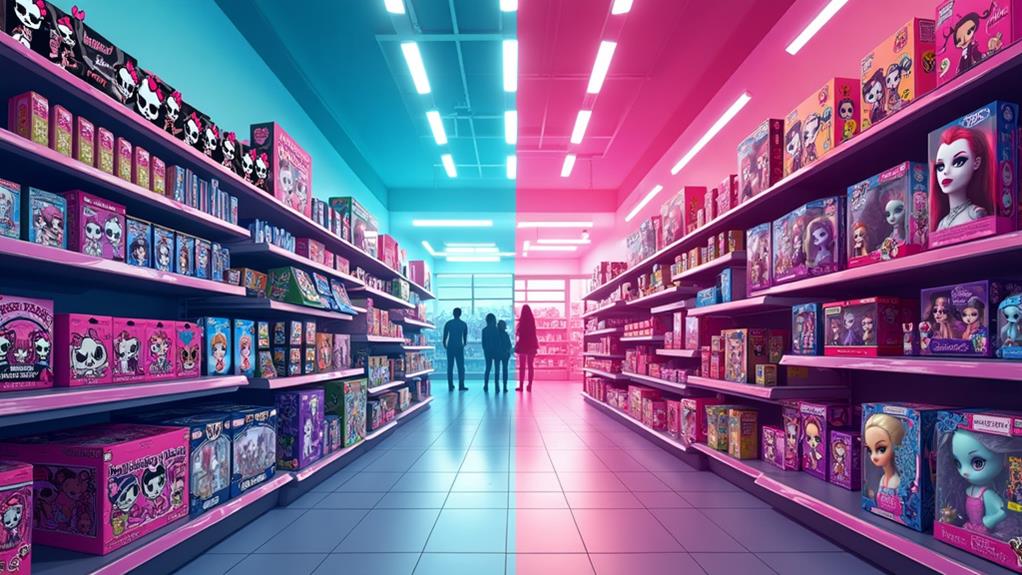
Monster High's meteoric rise in popularity created a unique space in the toy market, but it wasn't long before competitors began to take notice. You probably remember the quirky dolls with their bold designs targeting a more diverse audience. However, other brands quickly stepped up their game to capture a share of that target audience. Companies like MGA Entertainment, with their Bratz and later L.O.L. Surprise!, began to adjust their brand positioning to attract the same demographic Monster High had captivated.
Competitors started introducing their own edgy, fashion-forward dolls, each aiming to steal some of Monster High's thunder. When you look at the timeline, you can see how these rivals became more aggressive in their marketing strategies. They didn't just want a piece of the pie; they wanted the whole bakery. This intense competition led to market saturation, making it harder for Monster High to maintain its unique appeal.
As the landscape grew crowded, Monster High struggled to stay ahead. The brand's positioning as the go-to for inclusive, story-rich dolls became less distinct. Competitors narrowed the gap, offering similar features and narratives, making it increasingly difficult for Monster High to excel in a now cluttered market.
Changes in Trends
As the toy industry evolved, shifts in consumer preferences became inevitable. Monster High was no exception to these changes. The brand initially thrived due to its unique blend of fashion evolution and creative storytelling. However, as cultural shifts began to influence the market, the brand faced new challenges.
Social media played a significant role in these changes. Platforms like Instagram and TikTok became trendsetters, dictating what's hot and what's not. Kids and teens were now more attuned to these platforms, creating a preference for more immediate, shareable content.
- Fashion evolution: Trends in children's fashion changed, making some of Monster High's designs feel outdated.
- Animation styles: New animation styles emerged, making Monster High's look less appealing compared to modern cartoons.
- Gender representation: There was a growing demand for more diverse and inclusive toys that Monster High initially led but eventually lagged.
- Nostalgia factor: As original fans grew older, the nostalgia factor influenced collector trends but didn't attract younger audiences.
Additionally, the nostalgia factor drove older fans to collect, but it wasn't enough to sustain broad market appeal. Monster High had to navigate these complex cultural and social dynamics to remain relevant.
Declining Sales
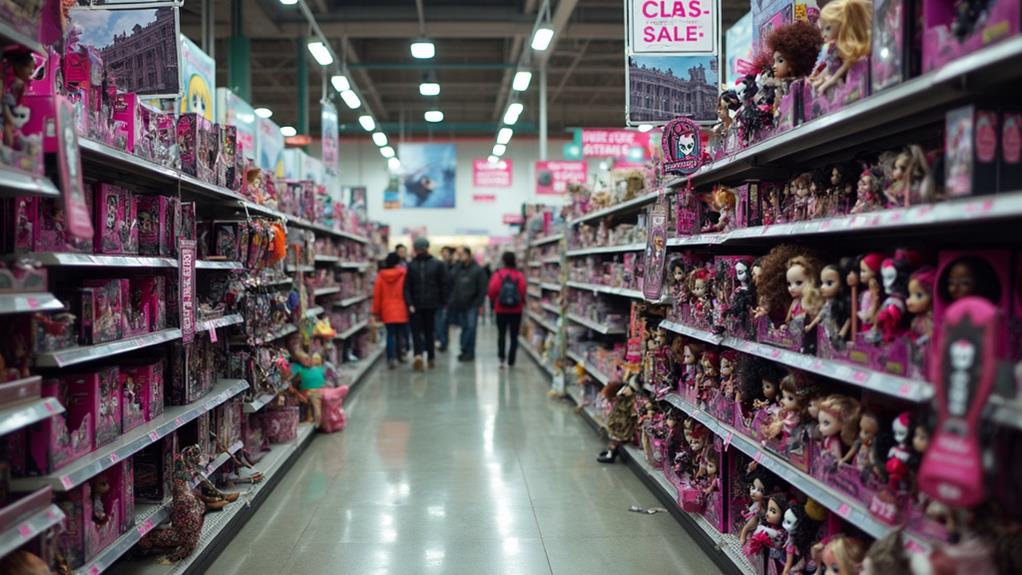
Sales numbers for Monster High began to wane as the brand struggled to keep pace with evolving consumer interests. Shifts in consumer preferences meant that what once captivated young audiences no longer held the same appeal. Declining demographics, particularly among the core demographic group, meant fewer kids were interested in the brand.
Economic factors also played a significant role. Families had to make more selective purchasing decisions, often opting for more versatile or educational toys. Monster High's specialized niche made it vulnerable to these shifts.
Moreover, sales strategies that once worked seemed outdated. The brand's heavy reliance on retail stores faced challenges as more consumers turned to online shopping. Retail challenges compounded the problem, with shelf space shrinking in favor of newer, trendier products.
Brand perception took a hit as well. Licensing issues and inconsistent product quality started to erode the brand's reputation. Product diversification efforts didn't always align with what consumers wanted, leading to a fragmented market presence. All these factors created a perfect storm, causing Monster High's sales to decline steadily.
Ultimately, the inability to adapt swiftly to these changes led to the brand's diminishing popularity.
Brand Overhaul Attempts
Recognizing the urgent need for change, the brand's creators initiated a thorough overhaul to recapture their audience. They redefined the brand identity, focusing on character evolution to make the ghouls more relatable and appealing. By refining marketing strategies, they aimed to reconnect with both old fans and attract new ones. They emphasized merchandise variety, introducing new dolls, accessories, and even clothing lines to diversify their offerings.
To enhance fan engagement, they utilized social media platforms, generating buzz and excitement around upcoming releases and updates. They also organized community events, allowing fans to engage themselves in the Monster High world and interact with like-minded individuals. The franchise expansion included multimedia ventures such as webisodes, movies, and books, further solidifying its place in popular culture.
- Redesigned dolls with modernized, relatable features
- Interactive social media campaigns and content
- Diverse merchandise including dolls, clothing, and accessories
- Special community events like meet-and-greets and themed parties
Fan Reactions
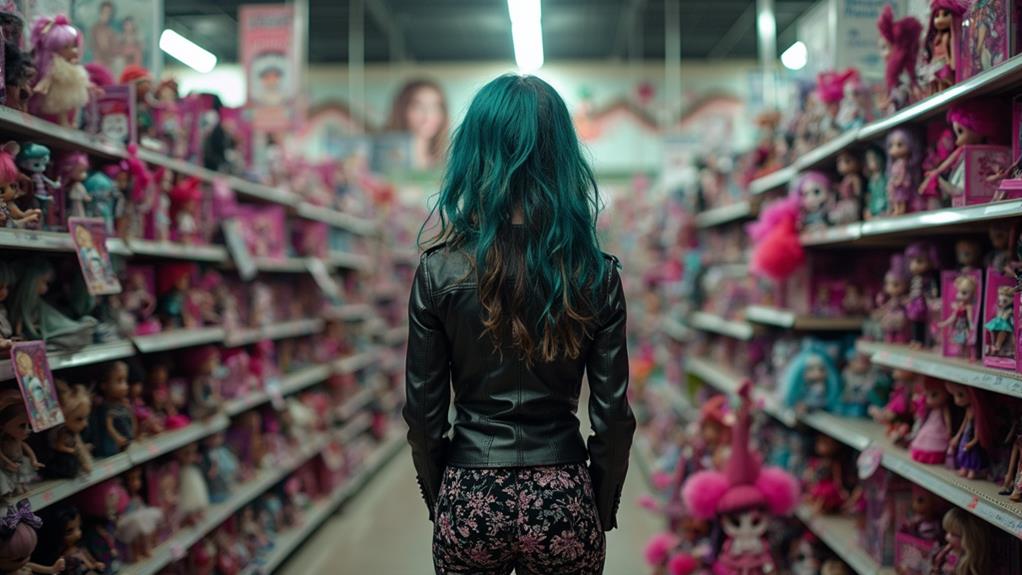
With the brand overhaul well underway, fans' reactions began pouring in, reflecting a mix of excitement and nostalgia. You could see the community engagement skyrocket across social media platforms. Long-time fans, who grew up with the original Monster High dolls, were thrilled to reminisce about their favorite characters and storylines. The sense of fan nostalgia was palpable, with many expressing their longing for the franchise's earlier days.
However, not all reactions were positive. Some fans felt the changes didn't honor the original spirit of Monster High. They voiced concerns about the new designs and story arcs, fearing that the brand was losing its unique identity. You might have noticed heated debates within fan forums and comment sections, where purists clashed with those more open to the new direction.
Despite the mixed feelings, one thing remained constant: the strong sense of community engagement. Fans organized online petitions, created fan art, and even held virtual meetups to discuss the brand's future. Regardless of whether they loved or loathed the changes, the passion for Monster High never wavered. This fervent community involvement underscored how deeply the franchise had impacted its audience.
Media and Merchandising
The resurgence of Monster High is evident not just in fan engagement but also in the media and merchandising landscape. You can see it in the way they've revamped their merchandising strategies and formed media collaborations to breathe new life into the brand. By targeting today's digital-savvy audience, they've made a striking comeback.
Consider these elements that paint a vivid picture of Monster High's renewed presence:
- Revamped Doll Lines: Improved designs and fresh characters that appeal to both nostalgic fans and new collectors.
- Animated Series: High-quality animations available on popular streaming platforms, capturing the essence of Monster High.
- Social Media Campaigns: Engaging content on Instagram, TikTok, and YouTube, creating buzz and fostering community.
- Collaborative Merch: Limited-edition collaborations with popular brands, making Monster High items must-haves.
They've executed these merchandising strategies with precision, ensuring each product and media collaboration aligns with current trends. From limited-edition dolls to high-quality animated series, Monster High has tapped into the heart of both old and new fans. These efforts have reignited interest and demonstrated that the brand isn't just surviving but thriving in a competitive landscape.
The Future of Monster High
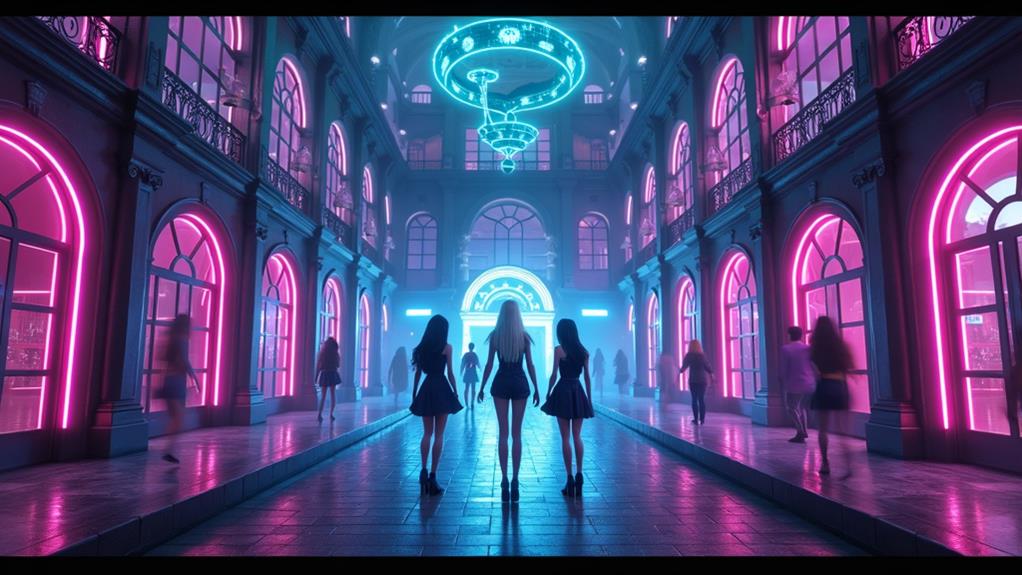
What lies ahead for Monster High as it continues to captivate audiences and redefine its legacy? The future holds promising prospects, with new adaptations and a focus on character evolution set to revive the brand's appeal. You can expect a fresh wave of animated series, movies, and even live-action adaptations that aim to modernize the franchise while staying true to its core essence. These new adaptations will likely introduce contemporary themes and more diverse characters, resonating with today's audience.
Character evolution will play a significant role in this revitalization. Classic characters like Frankie Stein and Draculaura might undergo transformations, reflecting current social issues and personal growth, making them more relatable. Moreover, new characters will be introduced, bringing fresh dynamics and expanding the Monster High universe. This evolution guarantees that the franchise remains relevant and engaging for both longtime fans and new followers.
In essence, the future of Monster High looks bright as it welcomes change and innovation. By focusing on new adaptations and character evolution, the brand is poised to re-enter the spotlight, capturing the imaginations of a new generation while honoring its rich legacy.

